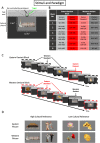Belief in biological origin of race (racial essentialism) increases sensitivities to cultural category changes measured by ERP mismatch negativity (MMN)
- PMID: 35292743
- PMCID: PMC8924166
- DOI: 10.1038/s41598-022-08399-3
Belief in biological origin of race (racial essentialism) increases sensitivities to cultural category changes measured by ERP mismatch negativity (MMN)
Abstract
The dynamic multicultural view explains culture-specific effects on cognition that cultural knowledge is organized in multiple knowledge systems which are specific to each culture and differentially activated when exposed to related objects or scenes. This view predicts automatic categorizations of environmental information according to the culture-specific knowledge systems. This study investigated whether cultural information could be spontaneously categorized, and the modulation of this process by the belief in the biological origin of race (i.e., racial essentialism) with an event-related brain potential, the visual Mismatch Negativity (vMMN). Deviant pictures of Eastern (Western) culture were randomly presented in a stream of standard Western (Eastern) pictures while participants were playing a video game. Participants who endorse racial essentialism (high group) showed vMMNs to the deviants with high relevance to the Eastern or Western culture and the deviant with low Eastern relevance; while participants with low racial essentialism showed vMMN to the deviant with high Eastern relevance only. These results revealed spontaneous cultural categorization with vMMN and the top-down modulation of spontaneous categorization by personal belief. In addition, this is the first demonstration of MMNs to cultural deviance and the potentials in applying MMNs to study psychological essentialism and social categorization.
© 2022. The Author(s).
Conflict of interest statement
The authors declare no competing interests.
Figures




References
-
- Chiu C, Leung AKY, Hong Y-Y. Cultural processes: an overview. In: Leung AKY, Chiu CY, Hong YY, editors. Cultural Processes: A Social Psychological Perspective. Cambridge University Press; 2011. pp. 3–22.
-
- Hong Y-Y, Morris MW, Chiu CY, Benet-Martínez V. Multicultural minds: A dynamic constructivist approach to culture and cognition. Am. Psychol. 2000;55:709–720. - PubMed
-
- Martin L, Shao B. Early immersive culture mixing: The key to understanding cognitive and identity differences among multiculturals. J. Cross. Cult. Psychol. 2016;47:1409–1429.
-
- Hong Y-Y, Fang Y, Yang Y, Phua DY. Cultural attachment: A new theory and method to understand cross-cultural competence. J. Cross. Cult. Psychol. 2013;44:1024–1044.
-
- Ross M, Xun WQE, Wilson AE. Language and the bicultural self. Personal. Soc. Psychol. Bull. 2001;28:1040–1050.
Publication types
MeSH terms
LinkOut - more resources
Full Text Sources

